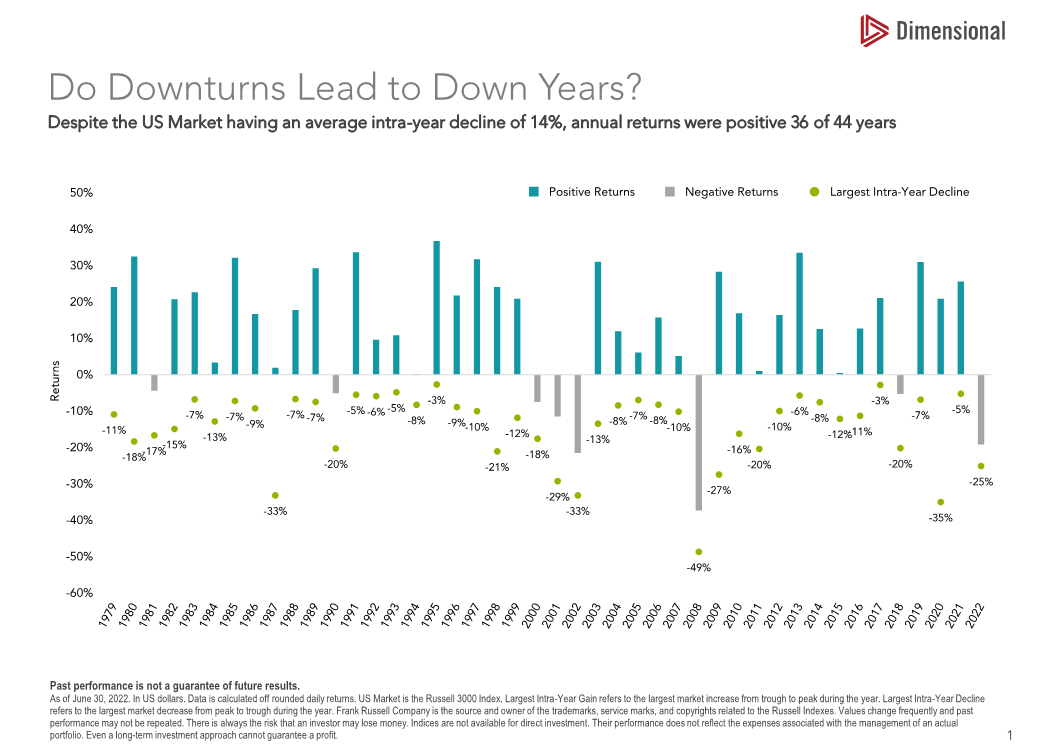During this period, the average intra-year decline was about 14%. Nevertheless, despite these substantial intra-year drops, calendar year returns were positive in 36 out of the 44 time periods examined—or 82% of the years. This data illustrates just how common market declines are and how poorly correlated they are to annual returns. Just because stocks fall sharply sometime during the year does not mean they will end the year with a negative return.
Debunking the Illusion of Market Timing
Since equity market swings happen so frequently, some investors may be tempted—or frightened—into trying to time the market. They want to get out “near the top” and buy back in again “near the bottom.” Certainly, the idea of using short-term strategies to avoid near-term pain, all without missing out on long-term gains, is seductive. But research repeatedly demonstrates that timing strategies are not effective. For a start, predicting equity market ups and downs is next to impossible, even if you think you know what is going to happen. Consider the most recent time period. US equities weathered a global pandemic, the Russian invasion of Ukraine, spiking inflation, a sharp rise in interest rates, bank failures, and ongoing recession fears. Despite all this bad news, equities generated robust positive returns for the three years ending February 28, 2023, with the Russell 3000 Index recording a sizable 11.79% annualized return. If they had been given a crystal ball forecasting these events in February 2020, few investors would have predicted higher equity prices over the next three years. The fact is markets do not react predictably to new information.
The Costly Consequences of Mistiming
Moreover, mistiming your exit and entry into the equity market, even by just a few days, can have a large detrimental impact on your portfolio’s return. Data analysis of the returns of the S&P 500 Index over the last 28 years ending September 30, 2022, shows that missing a very small number of “best” trading days (when the market return was greatest) causes a marked reduction in portfolio returns. For example, a portfolio that missed just 20 “best” days of the 6,993 trading days in the period covered cut returns by 65% compared to a portfolio that stayed fully invested over the entire period.
Embracing Diversification
Clearly, trying to time the market in an attempt to mitigate losses is a perilous activity. A wiser approach is to use diversification. Today, through mutual funds and ETFs, most investors can access broadly diversified investment strategies at very low cost. While some risks—specifically systematic risks such as that of recession—cannot be diversified away, diversification is still an incredibly effective tool for reducing non-systematic risk. In particular, by ensuring that all positions and exposures are relatively small as a percentage of the portfolio, diversification can reduce the potential pain of a poorly performing stock or sector. Diversification can also smooth out returns as different parts of a portfolio will be producing positive returns at different times.
The Power of Patience
When markets react negatively to events, many investors feel like they should be doing something with their portfolios. Often, headlines and pundits stoke these sentiments with predictions of more doom and gloom. Nevertheless, most investors would be far better off resisting the siren call to tinker with their portfolio and instead remember that market volatility is totally normal, that market timing usually destroys more wealth than it protects, and that diversification does a great job reducing risk.

